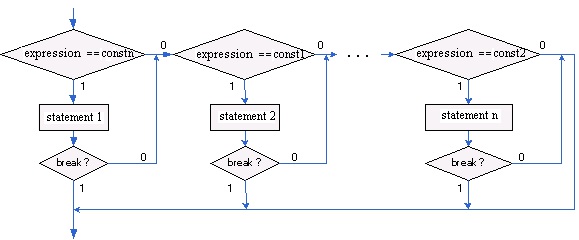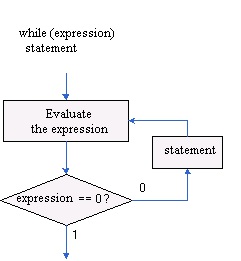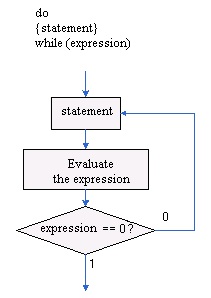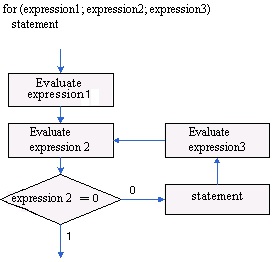++n;
The unusual aspect is that ++ and - - may be used either as prefix operators (before the variable,
as in ++n) or postfix operators (after the variable, as in n++). In both cases, the effect is to
increment n. But the expression ++n increments n before its value is used, while n++ increment n
after its value has been used. This mean that in a context where the value is being used, not just
the effect, ++n and n++ are different. For example, if n is 5, then
x = n++;
sets x to 5 but
x = ++n;
sets x to 6. In both cases, n becomes 6.
The increment and decrement operator can only be applied to variables; an expression like (i
+ j)++ is illegal.
Memory Addressing Operators
The five operators listed in the following table are used in addressing array elements and members of structures, and in using pointers to access objects and functions.
Table 2.15.
Operator Meaning
Example Result
&
Address of
&x
Pointer to x
*
Indirection operator
*p
The object or function that p points to
The element with the index y in the array x (or the
[ ]
Subscripting
x[y]
element with the index x in the array y: the [ ]
operator works either way)
Structure or union
.
x.y
The member named y in the structure or union x
member designator
Structure or union
The member named y in the structure or union
->
member designator by p->y
that p points to
reference
Type Conversions
When an operator has operands of different types, they are converted to a common type according
to a small number of rules. In general, the only automatic conversion era those that convert a
narrower operand into a wider one without loosing information, such as converting an integer into
floating point .
If there are no unsigned operands, the following informal set of rules will suffice:
If either operand is long double, convert the other to long double.
Otherwise, if either operand is double, convert the other to double.
Otherwise if either operand is float, convert the other to float.
Otherwise convert char and short to int.
Then if either operand is long, convert the other to long.
A char is just a small integer, so chars may be freely used in arithmetic expressions
Precedence of Operators
Operators listed by type.
All operators on the same line have the same precedence. The first line has the highest
precedence.
Table 2.16.
Level Operators
Associativity
1
() [] . -> ++ (postfix) – (postfix)
----->
2
! ~ ++ (prefix) -- (prefix) - * & sizeof <-----
3
* / %
----->
4
+ -
----->
5
<< >>
----->
6
< <= > >=
----->
7
== !=
----->
8
&
----->
9
^
----->
10
|
----->
11
&&
----->
12
|
----->
13
?:
<-----
14
= += -=
<-----
Note:
associate left to right
2.3. The Control Flow*
2.3. The Control Flow*
The control flow of a language specify the order in which operations are performed. Each program
includes many statements. Statements are processed one after another in sequence, except where
such control statements result in jumps.
Statements and Blocks
An expression such as x = 0 or i++ or printf(. . . .) becomes a statement when it is followed by a
semicolon, as in
x=0;
i++;
printf(. . . .);
In the C language, the semicolon is a statement terminator.
A block also called a compound statement, or compound statement, lets you group any number of
data definitions, declarations, and statements into one statement. All definitions, declarations, and statements enclosed within a single set of braces are treated as a single statement. You can use a
block wherever a single statement is allowed.
In blocks, declarations and definitions can appear anywhere, mixed in with other code. Note that
there is no semicolon after the right brace that ends a block.
Example 2.6.
{ into I = 0; /* Declarations */
static long a;
extern long max;
++a; /* Statements */
if( a >= max)
{ . . . } /* A nested block */
. . .
}
An expression statement is an expression followed by a semicolon. The syntax is:
[expression] ;
Example 2.7.
y = x; // Assignment
The expression—an assignment or function call, for example—is evaluated for its side effects.
The type and value of the expression are discarded.
A statement consisting only of a semicolon is called an empty statement, and does not perform
any operation. For Example
for ( i = 0; str[i] != '\0'; ++i )
; // Empty statement
If, If else statements
The if statement has two forms:
if(expression) statement
and
if(expression) statement1
else statement2
In the first form, if (and only if) the expression is non-zero, the statement is executed. If the
expression is zero, the statement is ignored. Remember that the statement can be compound; that
is the way to put several statements under the control of a single if.
The second form is like the first except that if the statement shown as statement1 is selected then
statement2 will not be, and vice versa.
Here are the flowcharts of the two forms of if statement

Figure 2.8.
The form involving else works the same way, so we can also write this.
if(expression)
if(expression)
statement
else
statement
this is now ambiguous. It is not clear, except as indicated by the indentation, which of the ifs is
responsible for the else. If we follow the rules that the previous example suggests, then the second if is followed by a statement, and is therefore itself a statement, so the else belongs to the first if.
That is not the way that C views it. The rule is that an else belongs to the first if above that hasn't already got an else. In the example we're discussing, the else goes with the second if.
To prevent any unwanted association between an else and an if just above it, the if can be hidden
away by using a compound statement, here it is.
if(expression){
if(expression)
statement
}else
statement
if(expression){
if(expression){
if(expression){

statement
}
}else{
statement
}
Example
Example 2.8.
#include <conio.h>
#include <stdio.h>
void main()
{
// variable declaration
float a, b;
float max;
printf(“ Enter the values of a and b: “);
scanf(“%f %f”,&a,&b);
if(a<b) //Assign the greater of x and y to the variable max
max = b;
else
max = a;
printf(“\n The greater of two numbers %.0f and %.0f is %.0f “,a,b,max);
getch();
}
Figure 2.9.
The Switch Statement
It is used to select one of a number of alternative actions depending on the value of an expression, and nearly always makes use of another of the lesser statements: the break. It looks like this.
switch (expression){
case const1: statements
case const2: statements
. . . .
default: statements
}

The flowchart of switch statement is shown below:
Figure 2.10.
The expression is evaluated and its value is compared with all of the const etc. expressions, which
must all evaluate to different constant values (strictly they are integral constant expressions). If any of them has the same value as the expression then the statement following the case label is
selected for execution. If the default is present, it will be selected when there is no matching value found. If there is no default and no matching value, the entire switch statement will do nothing
and execution will continue at the next statement.
Example 2.9.
OK=1;
switch (OP)
{
case ‘+’:
z=x+y;
break;
case ‘-’:
z=x-y;
break;
case ‘*’:
z=x*y;
break;
case ’/’:
if (y!=0 )
z=x/y;
else OK=0;
default :
OK=0;
}
The switch requires an integer-compatible value. This value may be a constant, variable,
function call, or expression. The switch statement does not work with floating – point data
types.
The value after each case label must be a constant.
C++ does not support case label with ranges of values. Instead, each value must appear in a
separate case label.
You need to use a break statement after each set of executable statements. The break statement
causes program execution to resume after the end of the current switch statement. If you do not
use the break statement, the program execution resumes at subsequent case labels.
The default clause is a catch-all clause.
The set of statements in each case or grouped case labels need not be enclosed in open and
close braces.
The following program writes out the day of the week depending on the value of an integer
variable day. It assumes that day 1 is Sunday.
#include <stdio.h>
#include <conio.h>
void main()
{int day;
printf(“Enter the value of a weekday”);
scanf(“%d”,&day);
switch (day)
{
case 1 : printf( "Sunday");
break;
case 2 : printf( "Monday");
break;
case 3 : printf( "Tuesday");
break;
case 4 : printf("Wednesday");
break;
case 5 : printf("Thursday");
break;
case 6 : printf("Friday");
break;
case 7 : printf("Saturday");
break;
default : printf("Not an allowable day number");
break;
}
getch();
}
If it has already been ensured that day takes a value between 1 and 7 then the default case may be
missed out. It is allowable to associate several case labels with one statement. For example if the
above example is amended to write out whether day is a weekday or is part of the weekend:
switch (day)
{
case 1 :
case 7 : printf( "This is a weekend day");
break;
case 2 :
case 3 :
case 4 :
case 5 :
case 6 : printf( "This is a weekday");
break;
default : printf( "Not a legal day");
break;
}
Loops : While and Do While, For
The while statement
The syntax of while statement is simple:
while(expression)
statement

Figure 2.11.
The statement is only executed if the expression is non-zero. After every execution of the
statement, the expression is evaluated again and the process repeats if it is non-zero. What could
be plainer than that? The only point to watch out for is that the statement may never be executed,
and that if nothing in the statement affects the value of the expression then the while will either do nothing or loop for ever, depending on the initial value of the expression.
Example 2.10.
#include <stdio.h>
#include <stdlib.h>
main(){
int i;
/* initialize */
i = 0;
/* check */
while(i <= 10){
printf("%d\n", i);
/* update */
i++;
}
}
The do statement
It is occasionally desirable to guarantee at least one execution of the statement following the
while, so an alternative form exists known as the do statement. It looks like this:
do
statement

while(expression);
Figure 2.12.
and you should pay close attention to that semicolon—it is not optional! The effect is that the
statement part is executed before the controlling expression is evaluated, so this guarantees at
least one trip around the loop. It was an unfortunate decision to use the keyword while for both
purposes, but it doesn't seem to cause too many problems in practice.
The for statement
A very common feature in programs is loops that are controlled by variables used as a counter.
The counter doesn't always have to count consecutive values, but the usual arrangement is for it to
be initialized outside the loop, checked every time around the loop to see when to finish and
updated each time around the loop. There are three important places, then, where the loop control
is concentrated: initialize, check and update. This example shows them.
As you will have noticed, the initialization and check parts of the loop are close together and their location is obvious because of the presence of the while keyword. What is harder to spot is the
place where the update occurs, especially if the value of the controlling variable is used within the loop. In that case, which is by far the most common, the update has to be at the very end of the
loop: far away from the initialize and check. Readability suffers because it is hard to work out
how the loop is going to perform unless you read the whole body of the loop carefully. What is
needed is some way of bringing the initialize, check and update parts into one place so that they
can be read quickly and conveniently. That is exactly what the for statement is designed to do.
Here it is.
for (expression1; expression2; expression3) statement

Figure 2.13.
The first expression (expression1) is the initialize part; nearly always an assignment expression
which is used to initialize the control variable. After the initialization, the check expression
(expression2) is evaluated: if it is non-zero, the statement is executed, followed by evaluation of
the update expression (expression3) which generally increments the control variable, then the
sequence restarts at the check. The loop terminates as soon as the check evaluates to zero.
There are two important things to realize about that last description:
one, that each of the three parts of the for statement between the parentheses are just expressions; two, that the description has carefully explained what they are intended to be used for without
proscribing alternative uses—that was done deliberately. You can use the expressions to do
whatever you like, but at the expense of readability if they aren't used for their intended purpose.
Here is a program that does the same thing twice, the first time using a while loop, the second
time with a for. The use of the increment operator is exactly the sort of use that you will see in
everyday practice.
Example 2.11.
#include <stdio.h>
#include <stdlib.h>
void main(){
int i;
/* the same done using ``for'' */
for(i = 0; i <= 10; i++){
printf("%d\n", i);
}
}
There isn't any difference between the two, except that in this case the for loop is more convenient and maintainable than the while statement. You should always use the for when it's appropriate;
when a loop is being controlled by some sort of counter. The while is more at home when an
indeterminate number of cycles of the loop are part of the problem.
Any of the initialize, check and update expressions in the for statement can be omitted, although
the semicolons must stay. This can happen if the counter is already initialized, or gets updated in
the body of the loop. If the check expression is omitted, it is assumed to result in a ‘true’ value
and the loop never terminates. A common way of writing never-ending loops is either
for(;;)
or
while(1)
and both can be seen in existing programs.
Loop Flow Control
The control of flow statements that we've just seen are quite adequate to write programs of any
degree of complexity. They lie at the core of C and even a quick reading of everyday C programs
will illustrate their importance, both in the provision of essential functionality and in the structure that they emphasize. The remaining statements are used to give programmers finer control or to
make it easier to deal with exceptional conditions. Only the switch statement is enough of a
heavyweight to need no justification for its use; yes, it can be replaced with lots of ifs, but it adds a lot of readability. The others, break, continue and goto, should be treated like the spices in a
delicate sauce. Used carefully they can turn something commonplace into a treat, but a heavy hand
will drown the flavor of everything else.
The break statement
This is a simple statement. It only makes sense if it occurs in the body of a switch, do, while or for statement. When it is executed the control of flow jumps to the statement immediately following
the body of the statement containing the break. Its use is widespread in switch statements, where it is more or less essential to get the control that most people want.
The use of the break within loops is of dubious legitimacy. It has its moments, but is really only
justifiable when exceptional circumstances have happened and the loop has to be abandoned. It
would be nice if more than one loop could be abandoned with a single break but that isn't how it
works. Here is an example
#include <stdio.h>
#include <stdlib.h>
main(){
int i;
for(i = 0; i < 10000; i++){
if(getchar() == 's')
break;
printf("%d\n", i);
}
}
It reads a single character from the program's input before printing the next in a sequence of
numbers. If an ‘s’ is typed, the break causes an exit from the loop.
If you want to exit from more than one level of loop, the break is the wrong thing to use. The goto
is the only easy way, but since it can't be mentioned in polite company, we'll leave it till last.
The continue statement
This statement has only a limited number of uses. The rules for its use are the same as for break,
with the exception that it doesn't apply to switch statements. Executing a continue starts the next
iteration of the smallest enclosing do, while or for statement immediately. The use of continue is
largely restricted to the top of loops, where a decision has to be made whether or not to execute
the rest of the body of the loop. In this example it ensures that division by zero (which gives
undefined behavior) doesn't happen
#include <stdio.h>
#include <stdlib.h>
main(){
int i;
for(i = -10; i < 10; i++){
if(i == 0)
continue;
printf("%f\n", 15.0/i);
/*
* Lots of other statements .....
*/
}
}
Of course the continue can be used in other parts of a loop, too, where it may occasionally help to
simplify the logic of the code and improve readability. It deserves to be used sparingly.
Do remember that continue has no special meaning to a switch statement, where break does have.
Inside a switch, continue is only valid if there is a loop that encloses the switch, in which case the next iteration of the loop will be started.
There is an important difference between loops written with while and for. In a while, a continue
will go immediately to the test of the controlling expression. The same thing in a for will do two
things: first the update expression is evaluated, then the controlling expression is evaluated.
Goto and Labels
Everybody knows that the goto statement is a ‘bad thing’. Used without care it is a great way of
making programs hard to follow and of obscuring any structure in their flow. Dijkstra wrote a
famous paper in 1968 called ‘Goto Statement Considered Harmful’, which everybody refers to and
almost nobody has read.
What's especially annoying is that there are times when it is the most appropriate thing to use in
the circumstances! In C, it is used to escape from multiple nested loops, or to go to an error
handling exit at the end of a function. You will need a label when you use a goto; this example
shows both.
goto L1;
/* whatever you like here */
L1: /* anything else */
A label is an identifier followed by a colon. Labels have their own ‘name space’ so they can't
clash with the names of variables or functions. The name space only exists for the function
containing the label, so label names can be re-used in different functions. The label can be used
before it is declared, too, simply by mentioning it in a goto statement.
Labels must be part of a full statement, even if it's an empty one. This usually only matters when
you're trying to put a label at the end of a compound statement—like this.
label_at_end: ; /* empty statement */
}
The goto works in an obvious way, jumping to the labeled statements. Because the name of the
label is only visible inside its own function, you can't jump from one function to another one.
It's hard to give rigid rules about the use of gotos, but, as with the do, continue and the break
(except in switch statements), over-use should be avoided. Think carefully every time you feel
like using one, and convince yourself that the structure of the program demands it. More than one
goto every 3–5 functions is a symptom that should be viewed with deep suspicion.
2.4. Pointers and Arrays*
From the beginning, we only show how to access or change directly the values of variables
through their names. However, the C language provides the developers an effective method to
access variables - pointer.
A pointer is a variable that contains the address of a variable. Pointers are much used in C, partly because they are sometimes the only way to express a compu









